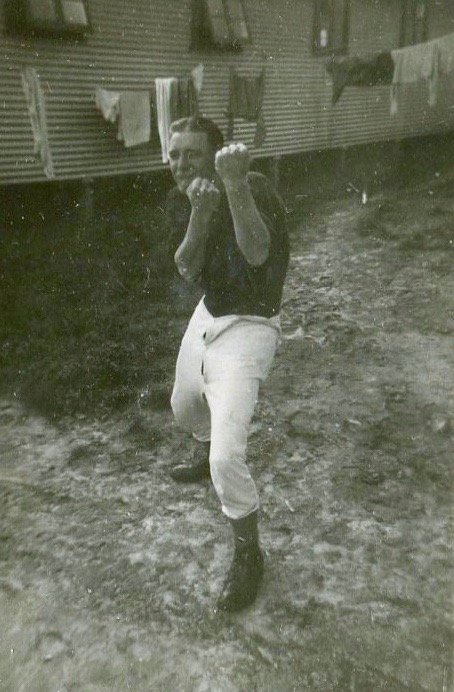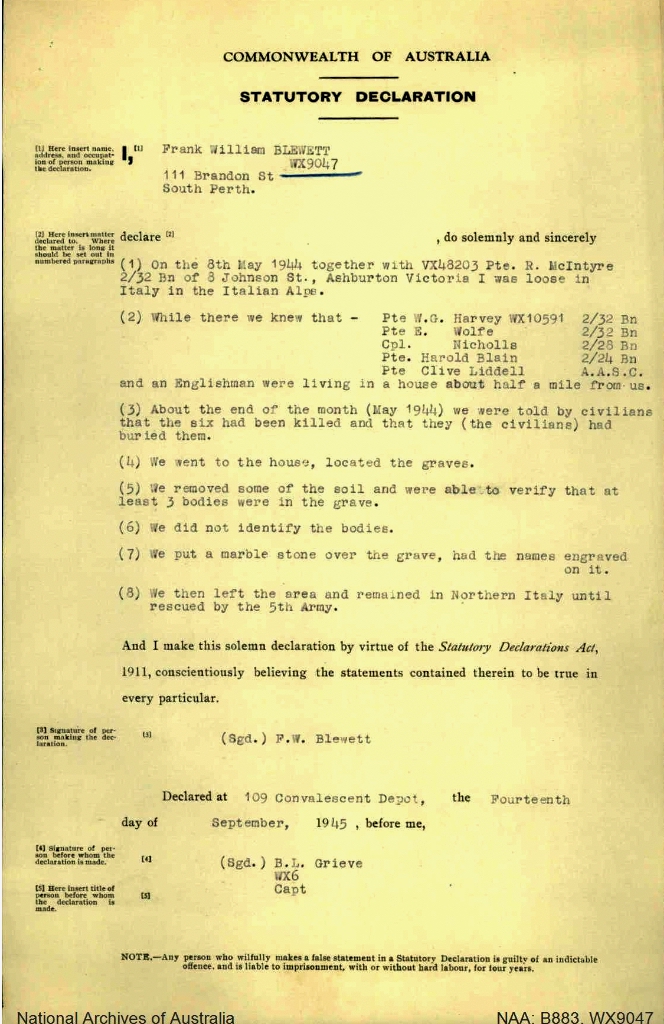The Soldier's Details

- Surname:
- Blewett
- First Name:
- Samuel James
- Rank:
- Private
- Regimental #:
- WX8631
- Classification:
- Rangetaker
- Company:
- A' Company
- Enlisted:
- 18.10.1940
- Discharged:
- 17.10.1946
- DOB:
- 4.01.1914
- Place of Birth:
- Gwalia, Western Australia
- Father's Name:
- Samuel James Blewett (Snr)
- Mothers's Name:
- Mary Blewett (nee Reid)
- Religion:
- Methodist
- Pre-war Occupation:
- Railways Porter
- Singapore:
- Selarang Camp Changi, Johore Bahru, Adam Park, River Valley Road Camp, Changi Gaol Camp
- POW#:
- 01/03/6981
- Return Details 1945:
- Singapore-Darwin-Melboume, lst Netherlands Military Hospital Ship Oranje Melbourne-Perth by troop train
General Description

Previously a Porter with WAGR, Blewett aged 26 1/2 years lived with his mother at 49 Ferguson Street, Maylands.
Blewett enlisted Oct 1940 and later joined ‘A’ Coy 5 Platoon and trained as a rangetaker.
He was taken POW of Japan 15 Feb 1942 and marched to Selerang Camp, Changi with thousands of Australian and British POWs.
Sam Blewett suffered asthma and therefore not selected with offshore work parties, remaining at Singapore throughout the war. He spent time at Kranji Hospital Camp, Woodlands.
___________
Blewett’s father, Samuel James Blewett (Snr) died 26 Feb 1917 in a mining accident at Sons of Gwalia aged 37 years at Leonora and was buried there. He was born 1879 at Bethanga, Towong Shire, Victoria to parents miner Charles Nickol Blewett and Catherine Uren. Samuel James Blewett (Jnr) would have been three years old. He was the third born of four children. Mary’s eldest child was son Frank who would have been 10 years old, Thomas 5 years and younger sister Catherine Blewett would have been two years when their father died.
In the 1912 Electoral Roll, Samuel James and Mary Blewett were residing Gwalia where he was a miner.
Samuel James and Mary Reid had married at Mt Margaret in 1906.
Mary was daughter of William and Sarah Read, born near Geraldton.
Mary Blewett died at Subiaco Dec 1962.
Mary Blewett’s (nee Read) father William Read died and was buried Yalgoo Cemetery 1882. William Read had married Sarah Sherry in 1866 Yandaooka. Mary’s mother Sarah (Sherry) died 1910 in Perth.
Unfortunately we have no further knowledge of Sam Blewett’s life after returning from war. We believe he never married.
He was fined several times for SP bookmaking or Street betting as was older brother Frank Blewett. Both sons recording their address Maylands (with their mother). Poor Mary, wonder whether she really knew what her grown up sons were doing. Frank was divorced in 1850. Both were employed as labourers.
Mary was paid compensation of 400 pounds when her husband died 1917. Also husband Sam’s probate provided about another 140 pounds. Mary was probably able to purchase the family home in Maylands. Her sons Frank and Sam certainly regarded the Maylands home as a family home. When Sam died he was living in Maylands.
Second son Thomas married 1933 and divorced 1947. He was the father of one daughter. He died in 1985.
Frank was father to one son. Frank died 1971.
Catherine married in 1939 and had two daughters and one son.
Mary Blewett’s (nee Read) father William Read died in
His older brother Frank William Blewett also enlisted WW2, WX9034 2/32 Btn. Frank was taken Prisoner at 1st Battle of El Alamein, Egypt Feb 1942.

9th Div arrived El Alamein 5th July 1942 and were directed to take up position at El Alamein Box in the front’s northern sector. Within days 9th Div was preparing for its first assault on enemy lines at Tel el Eisa. Tel el Eisa was the greatest success of July operations for both Australians and Eighth Army. It was the last operational victory in July, with subsequent operations failing to capture and hold objectives resulting in high casualties.
Please read further information about Australian POWs in Italy.
At the end of the First Battle of El Alamein, the Allies suffered about 13,250 wounded, captured, missing, and killed (3,700 British, 4,000 New Zealand, 3,000 Indian, 2,552 Australian), while the Axis suffered 17,000.
Please go to AWM for details of the battle at Ruin Ridge, El Alamein: https://www.awm.gov.au/articles/blog/1942-ruin-ridge
Below is an excellent and detailed account of Australians at El Alamein.
https://www.awm.gov.au/sites/default/files/road_to_ruin_australian_war_memorial_svss_townsend_0.pdf
Captured Allied soldiers were initially taken through German/Italian line (and subjected to English shelling)- we know Frank was trucked to Benghazi for shipment to Italy.
Frank was first interned in Italy at Camp PG 57 Grupignano 5 July 1943. 26 July 1943 He was moved to POW PG Camp 106 Vercelli, Piemonte, Italy. He escaped from Camp 106 which was not really a camp – please read the following explanation from AWM.


‘Campo 106, in northern Italy, was not a prison in the traditional sense, but a cluster of work farm camps where prisoners were put to work in surrounding rice fields. Prisoners were guarded by Italian army but not as rigorously as at some other camps across Italy or Germany.
On 8 September 1943, news broke Italy had formally surrendered to the Allies, with a secretly negotiated armistice agreement which included provision for handing over of Allied prisoners in Italy. The War Office in London sent messages to numerous camps that prisoners of war were to “stay put” pending the arrival of Allied forces. German authorities, of course, were not party to this agreement and had no intention of leaving Italy, nor of allowing all those prisoners to be released to roam behind their lines. Several days of confusion followed before the German Army could move in to secure all camps across Italy. In some camps pro-Fascist commandants or senior Allied prisoner of war enforced the stay put order; in others the Italian guards just opened the gates and left, leaving the prisoners temporarily unguarded.
This is what happened in Campo 106, allowing the prisoners of war, including many Australians, to leave and move south towards the advancing Allied forces or north to the Swiss border. Prisoner of War record cards indicate that about half of the prisoners in Campo 106 were able to make good their escape, most heading to Switzerland. Some died in the effort to escape, while the remainder were rounded up by the Germans and returned to captivity and sent to Germany.
It is estimated that about 17,000 of the 70,000 Allied prisoners of war in Italy escaped from various camps during this period, including some 500 Australians. But at least 50,000 prisoners were transferred to Germany to endure another two years as prisoners of war. Much has been written of the failure by Allied commanders to plan adequately for the security of those prisoners or to take account of the inevitable German response.’
Frank was one of the fortunate 500 Australians to escape from their Italian camp 106. While many former prisoners reached Switzerland, according to records attached below, Frank remained hidden with one other Australian soldier in northern Italy and was rescued by the US 5th Army. According to the below newspaper report Frank was first sent to the Italian coastal town of Bari. Then to Bournemouth,UK as a rescued POW and sailed for Sydney 14 Sept 1945.


Blewett (Jnr) died at Maylands 29 Jul 1959. He was only 45 years old. His body was cremated at Karrakatta and his ashes spread in the wind.
Below: 1901 Sam Blewett (Snr) plays for Kunanalling (originally known as 25 Mile) now an abandoned gold mining town 32 kilometres north west of Coolgardie. It was gazetted in June 1893 just a few months before Kalgoorlie.




Below: May 1910 Blewett seeks transfer of clubs.














